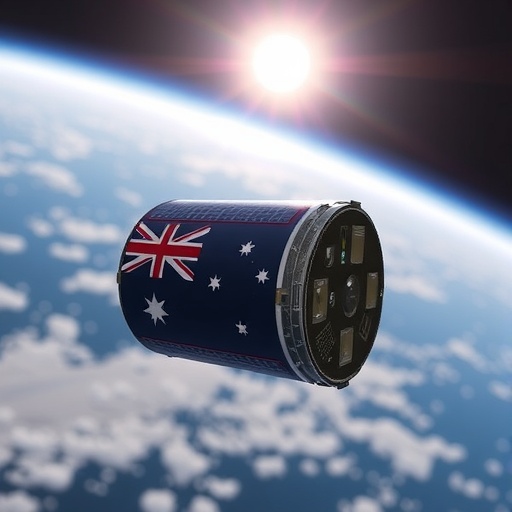Australia’s SpIRIT nanosatellite has achieved a significant milestone, marking the successful completion of its initial mission phase. This accomplishment not only highlights Australia’s growing reputation in the global space industry but also emphasizes the collaborative spirit of international partnerships in space exploration. As a pioneering effort led by the University of Melbourne in conjunction with the Italian Space Agency (ASI), SpIRIT stands as a remarkable example of innovation and technological advancement within the aerospace sector.
Since its launch on a SpaceX Falcon 9 rocket from California in December 2023, SpIRIT has made extraordinary progress. Over the past 600 days, the nanosatellite has orbited the Earth more than 9,000 times, covering a distance comparable to a round trip to Mars. This extensive journey signifies the robust capabilities of the spacecraft, which was engineered and developed in Australia. Onboard, it carries a scientific instrument provided by the Italian Space Agency, showcasing a blend of local expertise and international innovation.
Professor Michele Trenti, the Principal Investigator from the University of Melbourne, has expressed tremendous pride in the success of SpIRIT’s commissioning period. According to Professor Trenti, the satellite comprises several components that are being flown for the first time, which adds a layer of complexity to the mission. The coupling of Australian and Italian design philosophies culminates in a satellite equipped for advanced astronomical research.
With the first phase complete, SpIRIT is now prepared to enter a new stage focused on scientific observation rather than just testing technological capabilities. The transition marks a critical shift in the mission’s primary objectives. Throughout this next phase, SpIRIT’s HERMES X-ray detector will be employed to monitor vast expanses of space for gamma-ray bursts—phenomena that are the result of cataclysmic events such as stellar collisions or the demise of stars. Detecting these events presents challenges akin to finding a needle in a haystack due to their sporadic and transient nature.
As an innovative early warning system, SpIRIT will provide crucial alerts to astronomers concerning gamma-ray burst occurrences. This capability will enable scientists to redirect their instruments for detailed investigation at ambitious speeds. The satellite’s potential to contribute to our understanding of cosmic events truly emphasizes its significance in the Grande Narration of Space Science.
Moreover, the completion of SpIRIT’s initial mission phase was celebrated with the successful deployment of its winged thermal management system. This essential technology ensures that the satellite remains cool while maximizing its scientific output. Additionally, SpIRIT utilized a selfie stick to capture an image of itself in orbit. The resulting photograph, featuring emblems of various participating organizations, stands as a testament to the collaboration that has made the SpIRIT mission possible.
The cutting-edge design of SpIRIT includes unique wings crafted by the University of Melbourne, a feature that enhances thermal regulation and overall performance. In its operational configuration, the nanosatellite spans nearly one meter, representing a leap forward in compact satellite design for complex observational tasks. The transition into its final configuration indicates that SpIRIT is ready to embrace its new mission with confidence.
Enrico Palermo, the Head of the Australian Space Agency, acknowledged the significance of this milestone, noting the capabilities inherent in Australia’s space sector. Palermo elaborated on the satellite’s successful construction, rigorous testing both in orbit and on the ground, and its hosting of international scientific payloads. The high level of cooperation demonstrated between Australian and Italian agencies showcases the benefits of collaborative ventures in representing national scientific endeavors on a global stage.
Teodoro Valente, President of the Italian Space Agency, provided insights into the technological achievements linked to SpIRIT and the fruitful collaboration between Italian and Australian scientists. He acknowledged that the satellite carries a prototype detector funded by ASI, fully constructed in Italy under the auspices of INAF. The advancement of this sophisticated instrument has been validated by its preliminary operation, successfully capturing data about the Crab gamma pulsar within a very short observation window.
As SpIRIT advances into its observational phase, astronomers and scientists eagerly await the insights it will uncover. The unique capability of detecting gamma-ray bursts holds profound implications for astrophysics, especially regarding our understanding of cosmic phenomena and the life cycles of stars. SpIRIT serves not just as a technological innovation but as a beacon of hope for future explorations and discoveries that can redefine humanity’s comprehension of the universe.
In conclusion, SpIRIT’s successful initial mission phase underscores the essential role of international collaboration in expanding human knowledge of outer space. Its achievements reflect the potential for leveraging diverse expertise to tackle some of the most challenging questions in astronomy and astrophysics. As SpIRIT continues its journey, the scientific community stands ready to grasp the valuable data it will provide, further propelling our quest to understand the intricacies of the universe we inhabit.
Subject of Research: Observation of cosmic explosions (gamma-ray bursts) using SpIRIT nanosatellite.
Article Title: Australia’s SpIRIT Nanosatellite Completes Initial Phase, Transitioning to Scientific Observations
News Publication Date: October 2023
Web References: Not available
References: Not available
Image Credits: University of Melbourne
Keywords
SpIRIT, nanosatellite, gamma-ray bursts, University of Melbourne, Italian Space Agency, space exploration, astrophysics, international collaboration, HERMES X-ray detector, cosmic phenomena, satellite technology, scientific observations.




